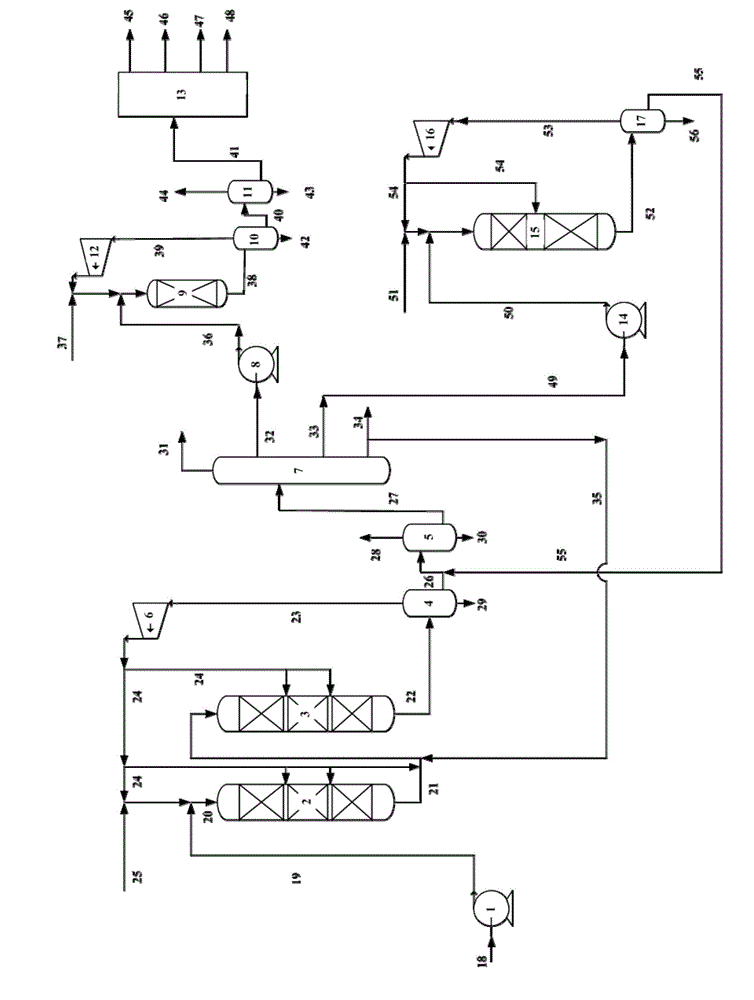Method for producing small-molecule aromatics from diesel oil raw material
A raw material and diesel technology, applied in the field of hydrocarbon oil cracking, can solve the problem of low octane number of gasoline fraction, and achieve the effect of excellent ring-opening cracking function
- Summary
- Abstract
- Description
- Claims
- Application Information
AI Technical Summary
Problems solved by technology
Method used
Image
Examples
Embodiment 1
[0055] The feed oil F enters the hydrorefining reaction zone together with the hydrogen, contacts and reacts with the protective agent A and the hydrofinishing catalyst B, and the reaction effluent from the hydrofinishing reaction zone enters the hydrocracking reaction zone I without any intermediate separation. The first hydrocracking catalyst C contacts and reacts. The reaction effluent from hydrocracking reaction zone I enters the separation facilities such as cold high-pressure separator I, cold low-pressure separator, and fractionation tower in sequence, and obtains light gasoline fraction, heavy gasoline fraction, middle distillate and tail oil after cooling, separation, and fractionation fraction. All tail oil fractions are recycled to hydrocracking reaction zone I to continue cracking and conversion.
[0056] The heavy naphtha enters the desulfurization unit, contacts and reacts with the desulfurization catalyst, removes thiophenes and mercaptans, and then enters the ...
Embodiment 2
[0060] The feed oil F enters the hydrorefining reaction zone together with the hydrogen, contacts and reacts with the protective agent A and the hydrofinishing catalyst B, and the reaction effluent from the hydrofinishing reaction zone enters the hydrocracking reaction zone I without any intermediate separation. The first hydrocracking catalyst C is contacted for reaction. The reaction effluent from hydrocracking reaction zone I enters the separation facilities such as cold high-pressure separator I, cold low-pressure separator, and fractionation tower in sequence, and obtains light gasoline fraction, heavy gasoline fraction, middle distillate and tail oil after cooling, separation, and fractionation fraction. Among them, 50% by weight of the tail oil fraction is used as a low-sulfur diesel blending component, and the remaining part of the tail oil fraction is recycled to the hydrocracking reaction zone I for further cracking conversion.
[0061] The heavy gasoline fraction e...
Embodiment 3
[0065] The raw material oil G enters the hydrofinishing reaction zone together with the hydrogen, contacts and reacts with the protective agent A and the hydrofinishing catalyst B, and the reaction effluent from the hydrofinishing reaction zone enters the hydrocracking reaction zone I without any intermediate separation, and The first hydrocracking catalyst C contacts and reacts. The reaction effluent from hydrocracking reaction zone I enters the separation facilities such as cold high-pressure separator I, cold low-pressure separator, and fractionation tower in sequence, and obtains light gasoline fraction, heavy gasoline fraction, middle distillate and tail oil after cooling, separation, and fractionation fraction. All tail oil fractions are recycled to hydrocracking reaction zone I to continue cracking and conversion.
[0066] The heavy naphtha enters the desulfurization unit, contacts and reacts with the desulfurization catalyst, removes thiophene and mercaptan, and then ...
PUM
| Property | Measurement | Unit |
|---|---|---|
| boiling point | aaaaa | aaaaa |
Abstract
Description
Claims
Application Information
 Login to View More
Login to View More - R&D
- Intellectual Property
- Life Sciences
- Materials
- Tech Scout
- Unparalleled Data Quality
- Higher Quality Content
- 60% Fewer Hallucinations
Browse by: Latest US Patents, China's latest patents, Technical Efficacy Thesaurus, Application Domain, Technology Topic, Popular Technical Reports.
© 2025 PatSnap. All rights reserved.Legal|Privacy policy|Modern Slavery Act Transparency Statement|Sitemap|About US| Contact US: help@patsnap.com

